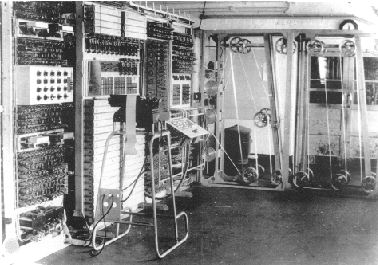The Colossus
its purpose and operation
by Tony Sale
| Back to Fish Index |
Tony Sale's
Codes and Ciphers
The Colossusits purpose and operationby Tony Sale| Back to Fish Index | |
 Tony Sale's Codes and Ciphers |
 |
 |
Colossus design started in March 1943. By December 1943 all the various circuits were working and the 1,500 valve Mark 1 Colossus was dismantled, shipped up to Bletchley Park, and assembled in F Block over Christmas 1943. The Mark 1 was operational in January 1944 and successful on its first test against a real enciphered message tape. This is a 1945 photograph of a Mk II Colossus. No pictures of the Mk I have been found, but the Mk I did not have the large switch panel rack with the sloping plug panel on its front and only had a sigle bedstead frame, like Heath Robinson. |
 | The racks were 90 inches, (2.3m), high of varying widths. There were eight racks arranged in two bays about 16ft (5.5m) long plus the paper tape reader and tape handler (known as the bedstead). The front bay of racks, spaced 5ft (1.6m) from the rear bay, comprised from right to left, the J rack holding the master control panel, the plugboard some cathode followers and the AND gates. |
 | Thyratrons are gas-filled triodes which strike a discharge arc between anode and cathode when the grid voltage is raised to allow electrons to flow. This discharge when struck continues quite independent of the grid voltage. Thus the thyratron acts as a one-bit store. It can only be switched off by driving both the anode and the grid negative with respect to the cathode. |
 |
| This page was originally created by the late Tony Sale the original curator of the Bletchley Park Museum Current website rebuild is being sponsored by Bedford SEO Agency Rich Sale Ltd. |